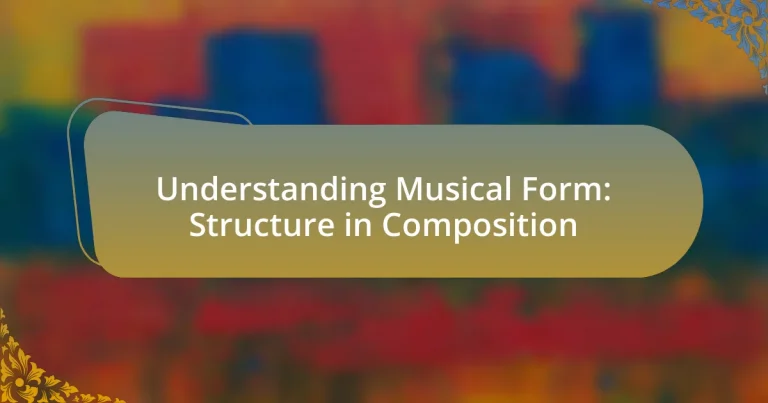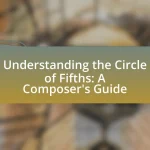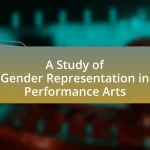Musical form in composition refers to the overall structure of a piece of music, encompassing how various sections are organized and interrelated. Key elements include repetition, contrast, and development, which contribute to the coherence and emotional impact of the music. Common forms such as binary, ternary, and sonata form provide frameworks for composers to explore themes and motifs, influencing both the composition process and listener perception. Understanding musical form is essential for composers, as it enhances their ability to convey ideas and emotions effectively while avoiding common pitfalls in structure. The article delves into the significance of musical form across different genres, its application in composition, and practical exercises for mastering these concepts.
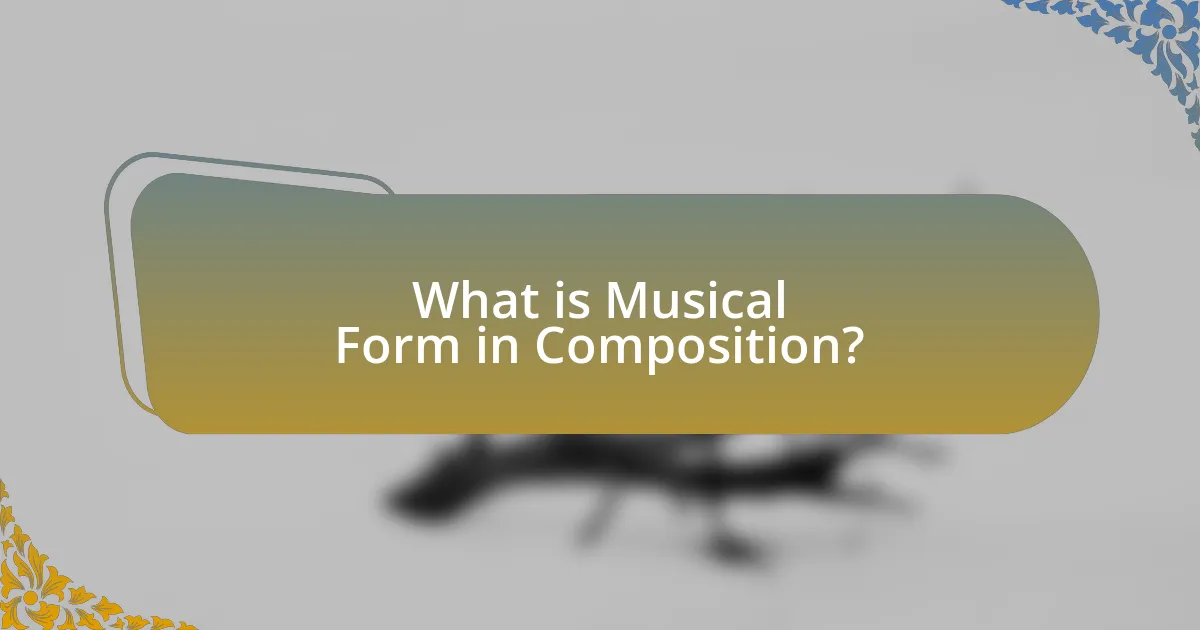
What is Musical Form in Composition?
Musical form in composition refers to the overall structure or plan of a piece of music, determining how various sections are organized and related to each other. This structure can include elements such as repetition, contrast, and variation, which help to create coherence and shape the listener’s experience. Common forms include binary, ternary, and sonata form, each with specific characteristics that guide the development of musical ideas. For instance, sonata form typically consists of an exposition, development, and recapitulation, providing a framework that composers use to explore themes and motifs.
How does Musical Form influence the overall structure of a piece?
Musical form significantly influences the overall structure of a piece by providing a framework that organizes musical ideas and themes. This framework dictates how sections of music are arranged, such as verses, choruses, and bridges, which helps to create coherence and flow within the composition. For example, in sonata form, the exposition, development, and recapitulation sections guide the listener through contrasting themes and their resolutions, establishing a clear narrative arc. The use of established forms, such as ABA or rondo, allows composers to manipulate expectations and create emotional impact, as seen in classical works by composers like Mozart and Beethoven, who effectively utilized these structures to enhance the listener’s experience.
What are the key elements that define Musical Form?
The key elements that define Musical Form are structure, repetition, contrast, and development. Structure refers to the overall layout of a piece, often categorized into sections such as verses, choruses, and bridges. Repetition reinforces themes and motifs, making them memorable, while contrast introduces variety and keeps the listener engaged. Development involves the transformation of musical ideas throughout the piece, allowing for progression and evolution. These elements work together to create a cohesive and engaging musical experience, as seen in classical compositions where sonata form exemplifies these principles through its clear exposition, development, and recapitulation sections.
How do composers utilize Musical Form to convey ideas?
Composers utilize musical form to convey ideas by structuring their compositions in ways that enhance thematic development and emotional expression. For instance, forms such as sonata-allegro, rondo, and theme and variations provide frameworks that guide the listener’s understanding of the narrative or emotional journey within the music. The sonata-allegro form, which includes exposition, development, and recapitulation, allows composers to present contrasting themes and explore their relationships, thereby deepening the listener’s engagement with the musical ideas. Historical examples include Beethoven’s Symphony No. 5, where the form underscores the struggle and triumph inherent in the thematic material. This structured approach not only organizes musical content but also reinforces the intended message or emotional impact, demonstrating the effectiveness of musical form in conveying complex ideas.
Why is understanding Musical Form important for composers?
Understanding musical form is crucial for composers because it provides a framework for organizing musical ideas and creating coherence in their compositions. By grasping various forms, such as sonata, rondo, or theme and variations, composers can effectively structure their works, ensuring that themes are developed and contrasted in a meaningful way. Historical examples, such as Beethoven’s use of sonata form, illustrate how mastery of musical structure can lead to innovative and impactful compositions. This understanding allows composers to engage listeners through familiarity while also enabling them to explore creativity within established frameworks.
How does Musical Form affect listener perception?
Musical form significantly influences listener perception by providing a framework that shapes how music is experienced and understood. The structure of a piece, such as its repetition, contrast, and variation, guides listeners in anticipating musical developments, which can evoke emotional responses. For instance, research by Huron (2006) in “Sweet Anticipation: Music and the Psychology of Expectation” demonstrates that predictable forms, like sonata or verse-chorus structures, enhance listener engagement by creating expectations that are either fulfilled or subverted, leading to heightened emotional reactions. Thus, the organization of musical elements directly impacts how listeners interpret and emotionally connect with the music.
What role does Musical Form play in different genres of music?
Musical form serves as a foundational structure that organizes compositions across various genres, influencing how music is created, perceived, and understood. In classical music, forms such as sonata, symphony, and concerto provide a framework for thematic development and contrast, allowing composers to explore complex ideas within a cohesive structure. In contrast, popular music genres like rock and pop often utilize simpler forms, such as verse-chorus, which facilitate memorability and audience engagement, as evidenced by the prevalence of catchy hooks and repetitive structures in chart-topping songs. Jazz employs forms like the 12-bar blues and AABA, which encourage improvisation while maintaining a recognizable structure, demonstrating how form can foster creativity within defined boundaries. Thus, musical form plays a critical role in shaping the identity and characteristics of different genres, guiding both composition and listener experience.
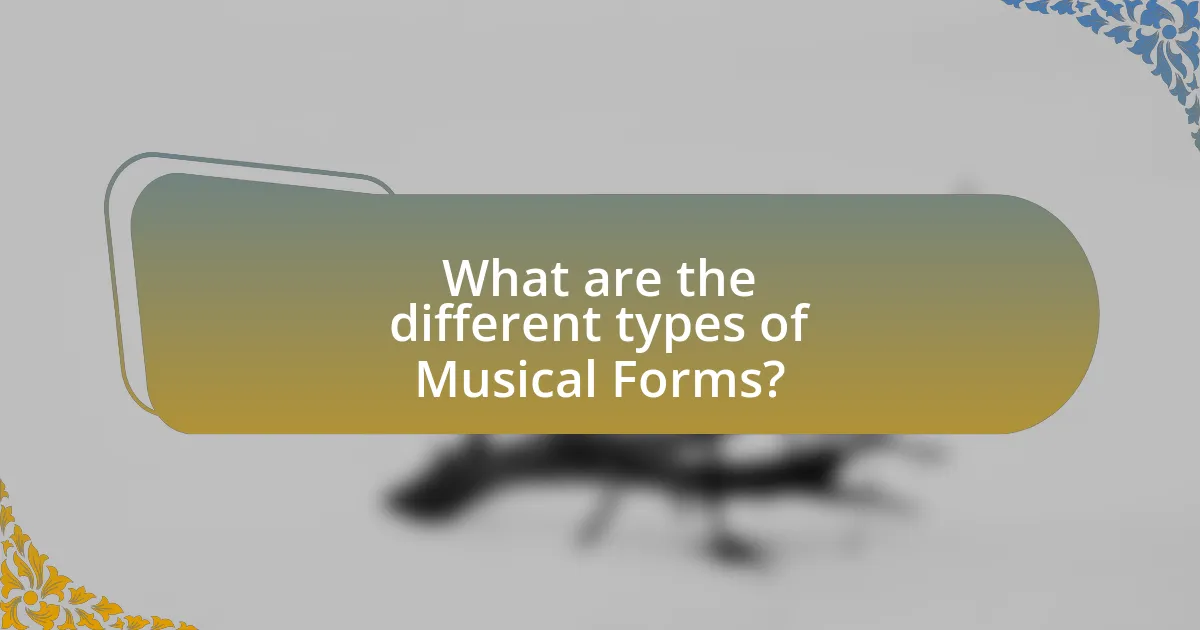
What are the different types of Musical Forms?
The different types of musical forms include binary, ternary, strophic, through-composed, and sonata form. Binary form consists of two contrasting sections (A-B), while ternary form features three sections (A-B-A), creating a sense of return. Strophic form repeats the same music for each stanza of lyrics, commonly found in songs. Through-composed form presents continuous, non-repetitive music, often used in art songs. Sonata form, prevalent in classical music, typically involves an exposition, development, and recapitulation, allowing for thematic exploration. Each of these forms serves distinct purposes in composition, shaping the structure and emotional impact of musical works.
How do Binary and Ternary forms differ?
Binary form consists of two distinct sections (A and B), typically structured as AABB, while ternary form includes three sections (A, B, and A), structured as ABA. The primary difference lies in the number of sections and their arrangement; binary form emphasizes contrast between two parts, whereas ternary form introduces a return to the initial section after contrasting it with a different section. This structural distinction is foundational in music composition, influencing the development of themes and motifs within a piece.
What are the characteristics of Binary form?
Binary form is a musical structure characterized by two contrasting sections, labeled A and B. Each section typically presents distinct musical ideas, with section A often being repeated, followed by section B, which may introduce new themes or variations. The A section usually establishes a key, while the B section often modulates to a different key, creating contrast. This form is prevalent in various musical genres, particularly in the Baroque period, where it served as a foundational structure for dances and instrumental pieces. The clarity and balance of binary form make it an effective tool for composers to explore thematic development and contrast within a concise framework.
What are the characteristics of Ternary form?
Ternary form is a musical structure characterized by its three-part layout, typically labeled as A-B-A. The first section (A) presents a theme, the second section (B) contrasts with a different theme, and the final section (A) returns to the original theme, often with slight variations. This form is prevalent in classical music, particularly in the works of composers like Haydn and Mozart, who utilized it to create balance and symmetry in their compositions. The repetition of the A section reinforces the thematic material, while the contrasting B section provides a sense of development and exploration within the piece.
What is the significance of Rondo and Theme and Variations?
Rondo and Theme and Variations are significant musical forms that showcase compositional creativity and structural coherence. Rondo, characterized by its recurring main theme interspersed with contrasting sections, allows composers to explore thematic development while maintaining listener engagement through repetition. Theme and Variations, on the other hand, involves presenting a theme followed by a series of variations that transform the original material, demonstrating the composer’s ingenuity in reinterpreting a single idea. Both forms are essential in classical music, as they provide frameworks for composers to express thematic exploration and variation, contributing to the overall narrative and emotional depth of a piece.
How does Rondo form create musical contrast?
Rondo form creates musical contrast through its alternating structure of recurring themes and contrasting episodes. In a typical rondo, a principal theme (A) is interspersed with contrasting sections (B, C, etc.), which provide variety and maintain listener interest. This contrast is achieved by varying elements such as melody, harmony, rhythm, and texture in the episodes, while the recurring theme serves as a familiar anchor. The effectiveness of this form in creating contrast is evident in classical compositions, such as Beethoven’s “Rondo in B-flat major, Op. 51,” where the interplay between the main theme and contrasting sections highlights the differences in musical character and mood.
What techniques are used in Theme and Variations?
Theme and Variations employs several techniques, including melodic alteration, harmonic modification, rhythmic changes, and textural variation. Melodic alteration involves changing the original theme’s notes while retaining its essence, while harmonic modification shifts the underlying chords to create a different emotional context. Rhythmic changes can involve altering the tempo or meter, providing a fresh perspective on the theme. Textural variation introduces different instrumental combinations or orchestration, enhancing the overall sound. These techniques allow composers to explore and develop the original theme in diverse ways, showcasing creativity and depth in musical composition.
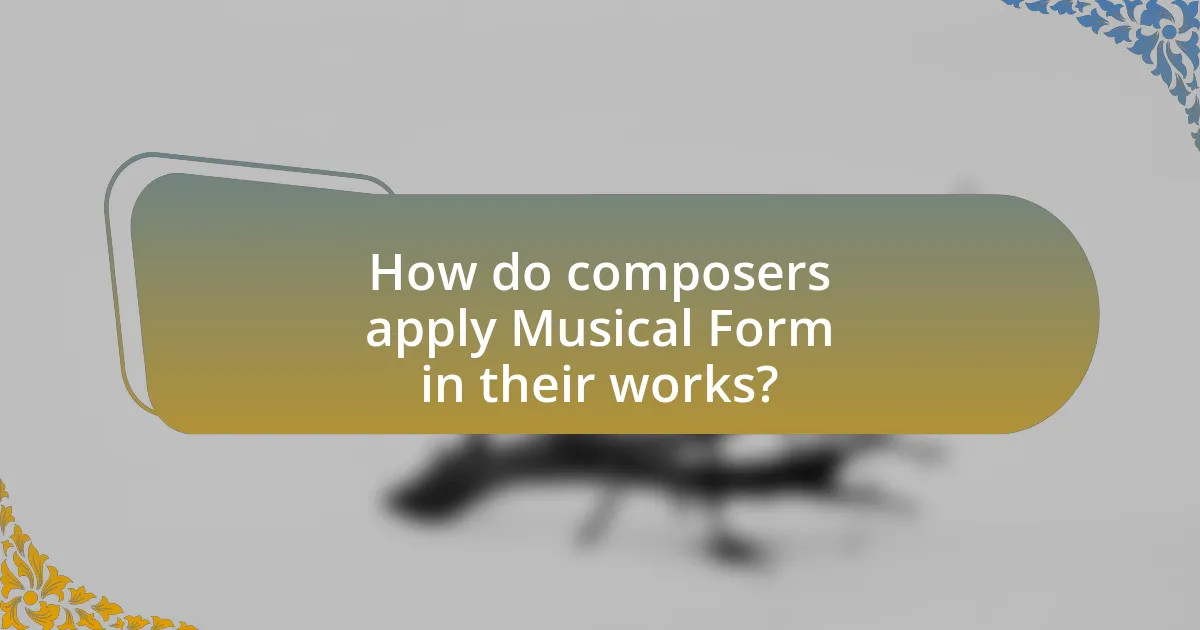
How do composers apply Musical Form in their works?
Composers apply musical form by organizing their works into structured sections that create coherence and guide the listener’s experience. For instance, classical composers often utilize forms such as sonata-allegro, rondo, and theme and variations to establish clear frameworks for their compositions. These forms provide a blueprint that helps in developing musical ideas, contrasting themes, and creating tension and resolution. The use of these established forms can be seen in the works of composers like Mozart and Beethoven, who effectively employed sonata form to structure their symphonies and sonatas, allowing for thematic development and emotional expression.
What strategies do composers use to develop Musical Form?
Composers use several strategies to develop musical form, including thematic development, variation, and contrast. Thematic development involves expanding and transforming a central theme throughout a piece, allowing for exploration of different musical ideas while maintaining coherence. Variation techniques, such as altering rhythm, harmony, or instrumentation, provide fresh perspectives on the original material, enhancing listener engagement. Contrast is employed by juxtaposing different sections or themes, creating dynamic shifts that maintain interest and structure. These strategies are foundational in various musical styles, as seen in classical compositions by Beethoven and modern works by composers like John Adams, demonstrating their effectiveness in shaping musical narratives.
How do transitions enhance the effectiveness of Musical Form?
Transitions enhance the effectiveness of musical form by providing coherence and continuity between distinct sections of a composition. They serve as bridges that connect contrasting musical ideas, allowing for a smoother flow and maintaining the listener’s engagement. For example, in sonata form, transitions facilitate the movement from the exposition to the development section, ensuring that the thematic material is effectively integrated and developed. This structural function is supported by the fact that well-crafted transitions can evoke emotional responses and create anticipation, thereby enriching the overall listening experience.
What are common pitfalls to avoid when using Musical Form?
Common pitfalls to avoid when using musical form include neglecting thematic development, failing to maintain coherence, and overcomplicating structures. Neglecting thematic development can lead to a lack of emotional impact, as themes need to evolve to engage listeners effectively. Failing to maintain coherence results in disjointed compositions that confuse the audience, undermining the intended message. Overcomplicating structures can detract from the music’s accessibility, making it difficult for listeners to follow and appreciate the piece. These pitfalls are supported by the principles of music theory, which emphasize the importance of clarity and progression in composition.
How can understanding Musical Form improve composition skills?
Understanding musical form enhances composition skills by providing a framework for organizing musical ideas effectively. Composers who grasp various forms, such as sonata, rondo, or theme and variations, can create more coherent and engaging pieces. This understanding allows for the strategic development of themes, the establishment of contrasts, and the creation of expectations for the listener. For instance, classical composers like Mozart and Beethoven utilized established forms to structure their works, which contributed to their lasting impact and clarity. By mastering musical form, composers can improve their ability to convey emotions and narratives through music, leading to more polished and professional compositions.
What practical exercises can help in mastering Musical Form?
Practical exercises that can help in mastering Musical Form include analyzing existing compositions, creating variations of a theme, and composing short pieces using specific forms such as sonata or rondo. Analyzing compositions allows musicians to identify structural elements and understand how different sections interact, while creating variations encourages creativity within a defined framework. Composing short pieces in established forms reinforces the application of theoretical knowledge in a practical context. These exercises are supported by educational methodologies that emphasize active engagement with musical structures, enhancing both comprehension and application of musical form.
How can analyzing existing works enhance understanding of Musical Form?
Analyzing existing works enhances understanding of Musical Form by providing concrete examples of structural elements and compositional techniques used by composers. This analysis allows musicians and scholars to identify patterns, such as the use of sonata form, rondo, or theme and variations, which are foundational to Western music. For instance, studying Beethoven’s symphonies reveals how he manipulated traditional forms to create emotional depth and complexity, illustrating the evolution of musical structure. Furthermore, examining works from different genres and periods, such as Baroque or Romantic, highlights the diversity of approaches to form, enriching one’s comprehension of how context influences compositional choices.
What are best practices for utilizing Musical Form in composition?
Best practices for utilizing musical form in composition include understanding and applying established structures such as sonata form, rondo, and theme and variations. These forms provide a framework that guides the development of musical ideas, ensuring coherence and clarity. For instance, sonata form, which consists of exposition, development, and recapitulation, allows composers to explore themes and their transformations effectively. Additionally, using repetition and contrast within these forms can enhance listener engagement and emotional impact. Historical examples, such as Beethoven’s symphonies, demonstrate the effectiveness of these practices in creating memorable and structurally sound compositions.
